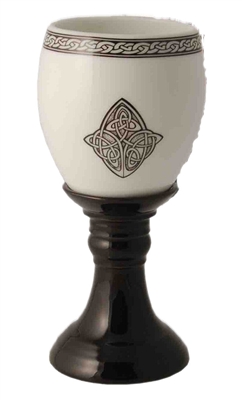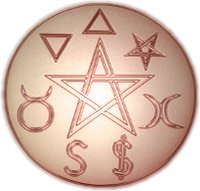The sacred drinking vessel is an essential ritual tool in almost every spiritual practice. Entire mythologies have been written solely on the subject such as the Akshaya Pathram, the Holy Grail, the Cup of Jamsshid and the Cornucopia just to name a few. As a tool it is used in any ritual where drinking something is done, be it blood, wine, or some hallucinogenic lubricant. As mentioned in The Sacred Meal, the cup is used to hold the blessings of the divine and to return those blessings to them.
And of course, in Traditional Wicca there are certain ways that it should be made. As the Receptive Feminine Tool it should be made of feminine materials such as clay or stone. I thought glass would have been fine, but I was told that it was too common and too modern to have the desired effect.
Silver is an option, but it tarnishes and can have odd chemical reactions with certain things like salt. Furthermore, one must be certain that what you are drinking out of is actually silver instead of plated because other showy metals can be toxic - just ask the Tudors.
As far as the general look of things go there isn't anything expressly traditional. Wiccans call their cup a "chalice" for religious and ostentatious reasons and as such the overall expected look of the sacred cup is that of a stemmed bowl or goblet. Though Indiana Jones would have us believe that the Holy Grail is a simple wooden cup fit for a carpenter and his fishermen buddies, the religious expression of that has been anything but simple.
Following in the footsteps of other sacred vessels like the Gunderstrup Cauldron or the Ardagh Chalice, most Pagans today like to have symbols of their faith on them. Depending on the tradition they may be simple or ornate, traditionally feminine like moons or symbolic of male deities like grapes.
Of course, there are those that take it too far...
And not all Contemporary Pagans choose to drink from a cup as their sacred vessel. Anything that can hold liquid qualifies and drinking horns are fairly common among Northern European Traditions like the Asatru. I actually use a horn on my person shrine because the stoneware cup I had for years was finally retired by a cat that was too curious about its contents. They generally require a stand to be set down on a surface and this can add some decoration and permanency to the altar even while the vessel is in use.
I would like to find or make a kylix eventually for my own uses. A kylix is a Classical Greek drinking vessel with a shallow bowl with two handles atop a stemmed base. They generally are decorated with images inside the bowl. The word kylix is the Greek root for the Latin calix that is in turn the root for the English chalice.
~A. Fox









